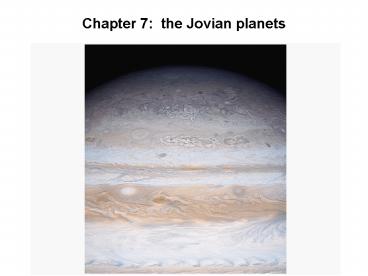Chapter 7: the Jovian planets PowerPoint PPT Presentation
1 / 29
Title: Chapter 7: the Jovian planets
1
Chapter 7 the Jovian planets
2
Comparing the planets
These can be divided into two groups terrestrial
and Jovian The differences are obvious in Mass,
Radius, and Average Density
3
Comparing the planets
4
Early Solar System Temperatures
Differentiation in the early solar system caused
most of the lighter material to condense out near
Jupiter and Saturn
5
Jupiter
Most of what we have learned about the Jovian
planets has come from spacecraft. Voyager I and
II Galileo and probe Cassini and Huygens probe
6
Saturn
Cassini is currently in orbit around Saturn and
is continually sending back more data about
Saturn and its moons.
7
Gravitational Slingshots are used for missions
to the outer planets, to save energy or to allow
heavier payloads.
8
Gravitational Slingshots were very successful
in the Voyager missions to all four Jovians.
9
Jupiters Interior
10
Jupiters Atmosphere
We know some things about the upper layers of
Jupiters atmosphere from the probe that was
carried by the Galileo spacecraft. It survived
until it was about 150 km below what we call the
surface of Jupiter.
11
Galileo probes entry site
12
Jupiters atmosphere has very obvious bands
13
(No Transcript)
14
(No Transcript)
15
(No Transcript)
16
(No Transcript)
17
(No Transcript)
18
Jupiters Convection
Jupiter radiates about twice as much heat as it
absorbs from the Sun. All this energy drives
Jupiters weather System as the heat moves up
from the interior.
19
Jupiters Red Spot is a very long-lived storm
We first observed Jupiters Great Red Spot over
300 years ago
20
Jupiters Brown Oval, a temporary feature
We have also seen other shorter lived structures
in Jupiters atmosphere, like this Brown oval,
which is really just a large hole in the outer
cloud layers of Jupiters atmosphere. All
jovian planets have differential rotation of
their atmospheres. So the rotation depends on
the latitude.
21
(No Transcript)
22
Pioneer 10 Mission studied the magnetic fields
All the Jovian planets have extensive magnetic
fields Jupiters extends well past the orbit
of Saturn!
23
Aurorae on Jupiter
Aurorae have been seen on both Jupiter and
Saturn.
24
(No Transcript)
25
Discovery 7-1A Cometary Impact
26
Shoemaker-Levy 9 Comet Impact
Tidal forces from Jupiter caused this comet to
break up. Then on a later orbit the fragments
hit Jupiter in 1994
27
Comet impact simulation using a supercomputer
28
(No Transcript)
29
Shoemaker-Levy 9 Comet Fragment G Impact

